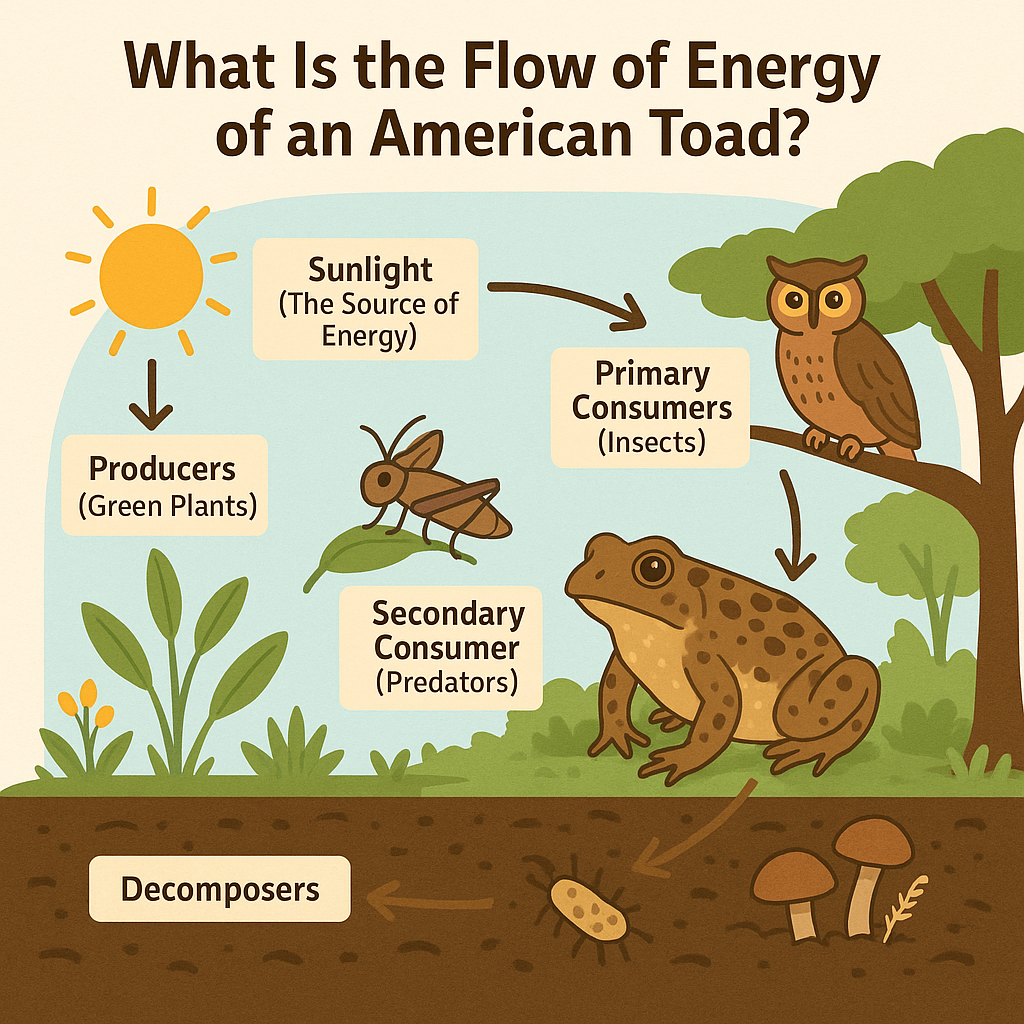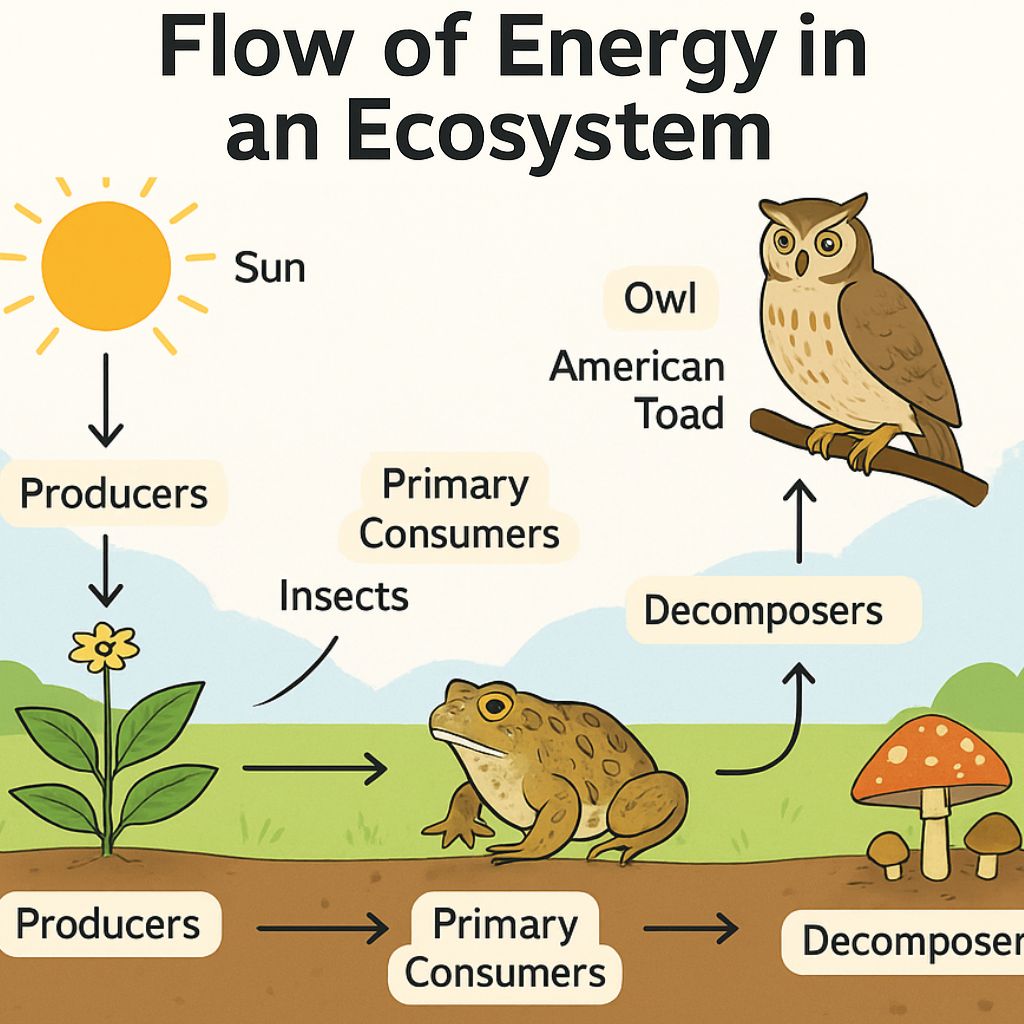
In nature, everything is connected through energy. From the tiniest plant to the largest predator, energy flows from one organism to another in a balanced cycle. One of the creatures playing a quiet yet vital role in this process is the American toad (Anaxyrus americanus). Though small, this amphibian is a key part of the food chain and ecosystem energy flow. You will find answer of you question what is the flow of energy of an American Toad?
In this detailed blog post, we’ll explore how energy moves through the environment, what role the American toad plays, what it eats, who eats it, and how it helps sustain life even after it dies.
What Is The Flow Of Energy Of An American Toad?
What is the flow of energy of an American toad is a question that helps us understand its role in the ecosystem. The process begins with sunlight, which plants use to make food through photosynthesis. These plants become food for insects, which are called primary consumers. The American toad eats these insects and becomes a secondary consumer. In this way, the toad gains energy that originally came from the sun, passing it along the food chain.
The flow of energy continues as predators such as snakes, owls, or raccoons eat the American toad, making them tertiary consumers. When these organisms die, decomposers like fungi and bacteria break down their bodies, returning nutrients to the soil. This natural cycle keeps energy moving and supports the growth of new plants, completing the loop. So, what is the flow of energy of an American toad is not just a question—it’s a key to understanding how life stays connected in nature.
How Energy Flows in Nature
Energy in nature flows in a specific direction—from the sun, to plants, to herbivores, and finally to carnivores. This path is called a food chain or energy flow. The American toad fits right into this system.
Sunlight: The Source of All Energy
The sun is the main energy source for all life on Earth. Without sunlight, plants can’t grow, animals can’t eat, and life would not exist. The energy from the sun is captured by plants and passed along to other organisms.
Producers: Green Plants
Plants are called producers because they produce their own food using sunlight, water, and carbon dioxide through a process called photosynthesis. In the American toad’s habitat, producers include grasses, mosses, shrubs, and garden plants.
Primary Consumers: Insects and Small Herbivores
The next step in the chain includes herbivores, like caterpillars, beetles, and grasshoppers. These are known as primary consumers because they eat plants and store the energy they get from them.
Secondary Consumers: The American Toad
The American toad is a secondary consumer. It doesn’t eat plants, but it eats the insects that feed on plants. These insects have already collected energy from plants, and the toad gets that energy by eating them.
Tertiary Consumers: Predators That Eat the Toad
Tertiary consumers are animals that eat the secondary consumers. In this case, the predators that eat the American toad include:
- Garter snakes
- Owls
- Foxes
- Raccoons
- Hawks
These animals store the energy they get from eating the toad and use it to survive and reproduce.
Decomposers: Nature’s Recyclers
When plants, insects, toads, or their predators die, decomposers like bacteria, fungi, and worms break down their bodies. The nutrients return to the soil, enriching it so that plants can grow. This completes the energy cycle.
What The American Toad Eats In The Energy Flow Cycle
The American toad has a big appetite for a small animal. It feeds mostly at night using its sticky tongue to catch prey. It eats a variety of insects and other small invertebrates such as:
- Ants
- Beetles
- Flies
- Moths
- Caterpillars
- Worms
- Slugs
- Spiders
An adult American toad can eat over 1,000 insects in one night. This not only helps the toad survive but also keeps pest populations in check. The energy stored in the insects’ bodies is passed to the toad, allowing it to move, grow, and reproduce.
Who Eats the American Toad?
Though the American toad has poison glands behind its eyes that secrete a milky toxin (called bufotoxin), some predators have adapted to eat them. These predators include:
- Snakes, especially garter snakes, that are immune to the toxin
- Owls and other birds that peck around the glands
- Foxes, raccoons, and skunks that know how to avoid the poison by flipping the toad over and eating the underside.
These predators gain energy from eating the toad, and that energy continues moving through the ecosystem.
Scientific Classification of the American Toad
Understanding where the American toad fits in the biological world helps us study its role more clearly. Here’s its classification:
- Kingdom: Animalia
- Phylum: Chordata
- Class: Amphibia
- Order: Anura
- Family: Bufonidae
- Genus: Anaxyrus
- Species: A. americanus
A Day in the Life of an American Toad
At sunset, the American toad wakes up from its hiding spot under leaves or rocks. It begins hopping through grass or forest floors, looking for movement. When it spots a beetle or a moth, it snaps out its tongue and swallows it whole. As it eats, it stores energy for survival.
During winter, the American toad hibernates underground. Its body slows down to conserve energy, living off the fat stored from summer meals. When spring arrives, the toad wakes up, eats again, and looks for a mate to begin the life cycle again.
Where Do American Toads Live?
American toads are found throughout North America and adapt well to different environments. They thrive in:
- Forests – under leaf litter
- Grasslands – in burrows or shaded areas
- Gardens – feeding on pests like slugs
- Wetlands – especially during mating season
In all of these habitats, the toad continues its role as a secondary consumer.
Understanding the Energy Pyramid
Energy in nature is organized in levels:
- Producers (plants) – Get energy from the sun
- Primary consumers (herbivores) – Eat plants
- Secondary consumers (American toad) – Eat herbivores
- Tertiary consumers (predators) – Eat secondary consumers
- Decomposers – Recycle all dead organisms
Each level passes less energy than the one below it, which is why there are more plants than toads, and more toads than snakes.
Why the American Toad Is Important?
The American toad may be small, but it plays an important role:
Pest Control
By eating insects, the toad helps protect crops and gardens.
Food Source
It is prey for snakes, birds, and mammals, helping support biodiversity.
Ecosystem Balance
Without the toad, insect populations could grow too large and damage plants.
Environmental Indicator
Toads are sensitive to pollution, so their presence shows a healthy environment.
How the Toad Helps Even After It Dies?
When the American toad dies, its body becomes part of the ecosystem:
- Decomposers break down its body
- Nutrients return to the soil
- Plants grow stronger using these nutrients
- Insects eat the plants
- Toads eat the insects again
This closed loop keeps the environment clean and full of life.
Threats to the American Toad
Despite its value, the American toad faces many threats:
Habitat Loss
Forests and wetlands are being cleared for buildings and roads.
Pollution
Chemicals from farms and factories contaminate water and soil.
Climate Change
Warmer temperatures and changing rain patterns affect where toads can live and breed.
Invasive Species and Pets
Dogs, cats, and non-native species can hurt or eat toads.
How to Help the American Toad
Here are simple ways to support toad populations:
- Avoid using pesticides and chemicals
- Keep your garden moist and shaded
- Leave rocks and logs for hiding places
- Build a small toad house or burrow
- Support wildlife conservation organizations
Even small actions can make a big difference.
The Energy Flow Involving the American Toad
Here’s how energy flows in nature, with the American toad at the center:
Sun → Plants → Insects → American Toad → Predators → Decomposers → Soil → Plants again
This cycle shows how energy never stops. Every plant, animal, and insect plays a role. The American toad helps keep that flow strong and balanced.
What Is The Flow Of Energy Among Organisms In An Ecosystem?

The flow of energy among organisms in an ecosystem begins with the sun, which provides energy to plants (producers) through photosynthesis. These plants are then consumed by herbivores (primary consumers), which in turn are eaten by carnivores or omnivores (secondary and tertiary consumers). As energy moves from one level to the next, it decreases, with only a small portion passed on most of it is lost as heat. When organisms die, decomposers like fungi and bacteria break down their remains, recycling nutrients back into the soil for plants to use again. This continuous energy transfer maintains balance in the ecosystem and supports all life forms.
Frequently Asked Questions (FAQs)
Q1: What type of consumer is the American toad?
It is a secondary consumer because it eats herbivorous insects.
Q2: What animals eat the American toad?
Snakes, owls, raccoons, foxes, and skunks.
Q3: What insects do American toads eat?
Ants, beetles, moths, worms, slugs, caterpillars, and more.
Q4: Why is the American toad important to ecosystems?
It controls pests, feeds predators, and recycles energy.
Q5: How do toads help after death?
Decomposers break down their bodies, enriching the soil.
Q6: How can I make my yard toad-friendly?
Avoid pesticides, leave moist areas, and provide shelter like rocks or overturned pots.
Q7: Where do American toads go in winter?
They hibernate underground in burrows.
Conclusion
The American toad is a silent hero in nature. From eating insects to feeding predators and returning nutrients to the soil, this small creature plays a large role in the flow of energy. Its life supports the health of plants, animals, and the land around us.
By protecting the toad, we protect an entire chain of life. Let’s do our part by creating safe, natural spaces and sharing the story of this amazing amphibian.